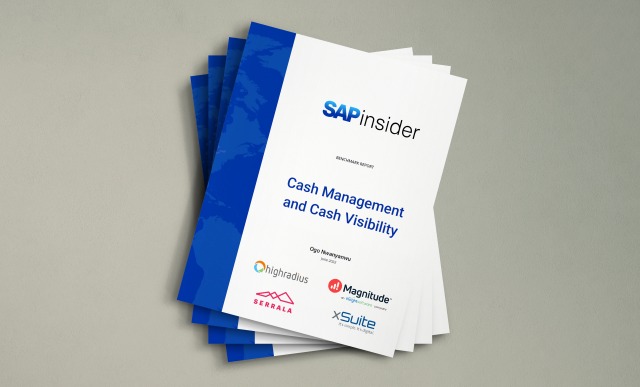Navigating the Storm of Global Cash Visibility with Kyriba’s Bob Stark
Meet the Authors
Key Takeaways
⇨ Finance leaders continue to struggle with visibility of cash and liquidity, impacting decision making.
⇨ SAPinsider sat down with Kyriba’s Bob Stark to explore the challenges preventing financial visibility at SAP organizations.
⇨ By ensuring Treasury Management Systems (TMS) work in tandem with SAP ERP, SAPinsiders can overcome existing barriers to enable intelligent financial decision making.
Imagine navigating a storm without a compass; that’s what decision making feels like without a comprehensive view of cash flow and liquidity, particularly during volatile operational periods. This analogy was at the heart of a recent conversation with Bob Stark, Global Head of Market Strategy at Kyriba, where he illustrated the challenges organizations face in realizing global financial visibility.
A prime example Stark shared is the dilemma of corporate subsidiaries borrowing overseas in the current rate environment. He suggests intercompany borrowing may be a better strategy for subsidiaries thereby allowing parent organizations to invest in themselves at a more favorable rate.
“Maybe these subsidiaries overseas should not borrow money in this environment. They should borrow from the intercompany standpoint, so the organizations can invest in themselves and not pay 9%, but earn 5%,” Stark said. The insight surfaces a wider issue: the need for complete visibility over every aspect of an organization’s financial operations. Without it, a business may not be able to make the most advantageous financial decisions.
The issue of visibility was a consistent theme during the conversation, aligning with preliminary findings from SAPinsider’s upcoming Cash Management and Visibility benchmark report. The study uncovered that a staggering 95% of SAPinsiders feel they lack the necessary visibility of cash and liquidity. Without this visibility, it becomes impossible to make intelligent decisions regarding cash flow and liquidity management.
Overcoming Barriers to Global Cash Visibility
Several key barriers preventing businesses from achieving global visibility of cash flows and liquidity emerged during the conversation. These barriers include limited buy-in from decision makers, competing priorities, customizations across cash management processes, lack of funding for the transformation of cash management processes, and readiness for real-time analytics.
Addressing these barriers effectively can lead to improved visibility, planning, and execution. For Stark, overcoming these barriers is not just about having the right tools but using them effectively.
“Organizations need to implement and integrate tools effectively to have the visibility that enables efficient planning and execution,” Stark said. By integrating the tools effectively with existing systems and ensuring accurate and readily available data, businesses can unlock their potential and achieve better cash flow visibility.
Role of TMS in Complementing SAP as the Single Source of Record
Our findings continue to highlight integration is crucial. Stark states, “You have SAP as the biggest system in the CFO’s office, but arguably across the enterprise. It is your single source of record. No one would ever dispute this.” He underscores the need for processes and tools that can pull data from various sources, accurately assimilate it, and generate insights to guide decision making.
Stark also discussed the importance of Treasury Management Systems (TMS) working in tandem with SAP ERP, rather than replacing it. TMS serves different use cases, and those suggesting an “instead” approach complicate the process for SAP Treasury users. Avoiding internal conflicts by convincing stakeholders to abandon a tool in which the organization has significantly invested is key.
One key topic that emerged during the discussion was the utilization of SAP’s Treasury module. When asked how many organizations leverage this module, Stark said, “It’s pretty minimal.” He explained that, while many companies have access to the SAP Treasury module and other tools, the actual utilization of these modules and tools is relatively low. Stark referred to this as a “gray area” – a middle ground where some functionalities are used while others are ignored.
Focus on Achieving the Desired Outcome
In response to the apparent underutilization of the treasury module and other tools, Stark identified alternative solutions that businesses often employ. These alternatives range from spreadsheets to treasury management systems and to modular systems that allow customization. What matters is not so much the tool used but the ability to achieve the desired outcome. The goal for any organization is to attain full visibility and automation, thereby minimizing manual processes and maximizing productivity.
However, realizing this ideal state is easier said than done, as Stark points out, due primarily to process and data-related challenges, not shortcomings of the tools themselves. The intricacy of business operations and the interconnected nature of data sources necessitate a novel approach for efficient management and effective utilization of these resources.
The importance of integration and automation cannot be emphasized enough. Stark highlighted how crucial these aspects are for organizations to make intelligent financial decisions. Despite having access to powerful tools like SAP’s Treasury module, many businesses are not utilizing them to their full potential. However, Stark’s insights provide a way forward, outlining the need for integration, customization, and effective utilization to overcome the existing barriers and achieve better cash flow visibility.
What does this mean for SAPinsiders?
Optimization of Existing Tools: For SAP customers, Stark’s insights emphasize the importance of maximizing the use of their existing SAP Treasury module. Rather than seeking alternative tools, organizations should aim to fully utilize the capabilities of the SAP system they already have in place. Consider alternative tools to address business or industry specific use cases and gaps in the core system. This indicates that SAP customers should focus on integrating complementary tools rather than considering replacement options.
Prioritize integration and automation to enhance visibility: Emphasize strategies that enhance the seamless integration of multiple data sources. Automation should play central role in reducing manual activities required to consolidate financial data thus enhancing data quality by improving timeliness and accuracy of information.
Align Tools with Desired Outcomes: It is not about what tools you use, but how you use them. Align your tools and strategies with the actual outcomes you want to achieve. Success should be measured not by utilization but by the results achieved through effective integration and accurate data management.





